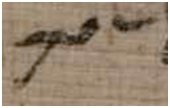Cursive Script
P.Oxy. XLIV 3180. Receipt for Φόροι, Διδραχμία and Ζευγματικά
α (ἔτουc) Γαίου Μεccίου Κυίντου Τραιανοῦ
Δεκίου Καίcαρ[ο]c τοῦ κυρίου, Μεcορὴ ια ̄<
διέγ(ραψεν) Αὐρη(λίῳ) Διονυcίῳ τῷ κ(αὶ) Ἀπολλωνίῳ
‘Year I of Gaius Messius Quintus Traianus
Decius Caesar the lord, Mesore II.
Paid to Aurelius Dionysius also called Apollonius’
Two notable features that make documents such as this difficult to read (even for experts!) are the abundance of abbreviations and the way that some letters seem to disappear in the connexions between surrounding letters.
Abbreviations may be marked by either a vertical , a horizontal or diagonal slash, or sometimes by nothing at all–-a word may simply break off.
ΔΙΕΓ| = διέγ(ραψεν). διέγραψεν ‘he paid’ was, as you can imagine, a very common word in receipts, so it was often abbreviated. Here the abbreviation is marked by a ‘vertical’slash after the first four letters of the word.
ΑΥΡΗ ̄ = Αὐρη(λίῳ). Here we see the name Αὐρηλίῳ (dative of Αὐρήλιοc; the case of the unabbreviated name has to be inferred from the context) abbreviated with a horizontal slash. Certain common prenames, like Αὐρήλιοc, were regularly abbreviated without much confusion in documents like this, where you expect to see names. (We need to know who is paying whom!)
 no indication of abbreviation:
no indication of abbreviation:
TΩKA = τῷ κ(αὶ) Ἀ[: here we see the very common word καὶ ‘and’ abbreviated without indication; the word just stops after the first letter κ. (Think of all the various shorthand ways of writing ‘and’ there are in other languages.) Fortunately, very few words are ever abbreviated in this manner.
Ligatures can also make words difficult to decipher, and sometimes letters in cursive script are compressed.
 ΔΕΚΙ: here you can see how the epsilon, kappa, and iota are joined into what could look like only one or two letters.
ΔΕΚΙ: here you can see how the epsilon, kappa, and iota are joined into what could look like only one or two letters.
 ΚΑI[: this combination is more difficult, as the alpha is extremely simplified and integrated into the ligatures. Note also that these are the first three letters of Καίcαρ[ο]c but there is a gap between the iota and the following sigma.
ΚΑI[: this combination is more difficult, as the alpha is extremely simplified and integrated into the ligatures. Note also that these are the first three letters of Καίcαρ[ο]c but there is a gap between the iota and the following sigma.
 ]ΝΥΣΙ[ from Διονυcίῳ. Again, we see that letters can be greatly compressed; the sigma here is hard to distinguish from the ligature and the length of the iota can be misleading.
]ΝΥΣΙ[ from Διονυcίῳ. Again, we see that letters can be greatly compressed; the sigma here is hard to distinguish from the ligature and the length of the iota can be misleading.
 ΤΟΥ: here we see that the final two letters of τοῦ are small and elevated, almost a superscript. This does not fit precisely in either of the above categories, but is worth pointing out as a common feature of cursive documents. Note that it appears at the end of Δεκίου and κυρίου in the same line.
ΤΟΥ: here we see that the final two letters of τοῦ are small and elevated, almost a superscript. This does not fit precisely in either of the above categories, but is worth pointing out as a common feature of cursive documents. Note that it appears at the end of Δεκίου and κυρίου in the same line.
Marco Perale, Rachael Cullick, Ryan Seaberg (University of Minnesota)



